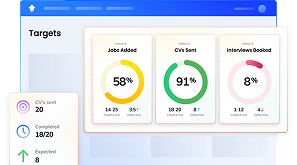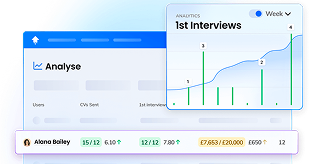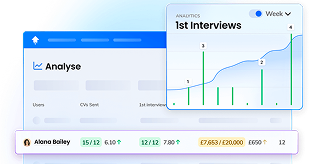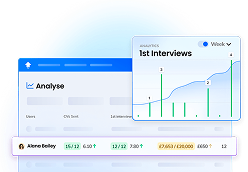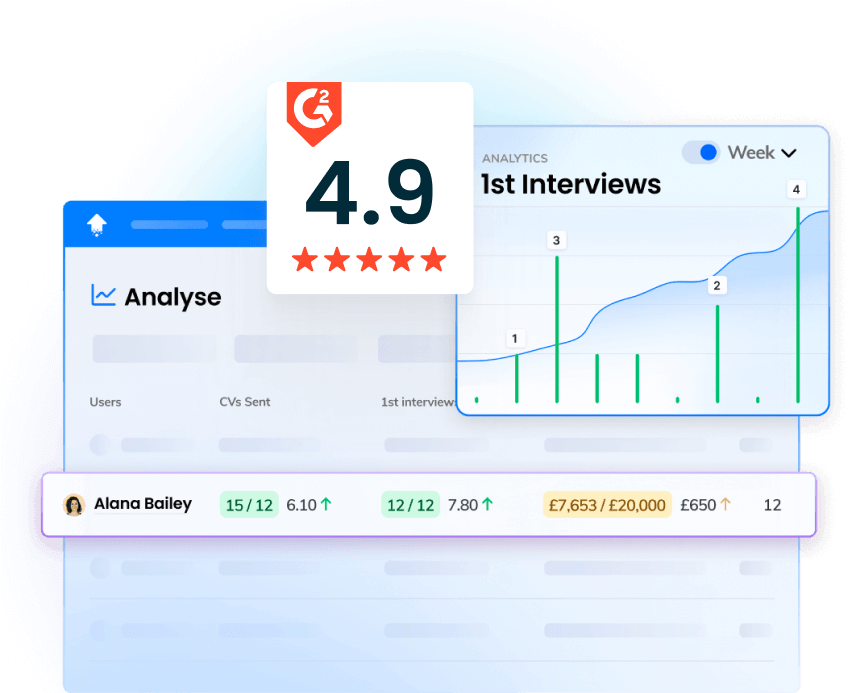The concept of Big Data has been around for a while now.
But as recruitment analytics tools become increasingly advanced, the importance of Big Data in our industry is only growing.
Indeed, as traditional recruitment methods, like manual screening and intuition-based hiring, become less effective in today's fast-paced market, recruiters need data-driven strategies—and Big Data is central.
By adopting Big Data, agencies can leverage analytics to gain deeper insights into candidate suitability, streamline the hiring process, and reduce bias.
Embracing this technology is essential for staying competitive, ensuring better hires, and enhancing overall recruitment efficiency.
What is Big Data in Recruitment?
Big Data in recruitment refers to using large, complex datasets to inform and refine hiring decisions.
This data comes from sources like social media, job boards, and internal databases.
By analysing this data, recruiters can accurately assess candidate qualifications, cultural fit, and potential.
This data-driven approach replaces traditional guesswork, ensuring more precise matches and a more efficient recruitment process.
The Benefits of Big Data in Recruitment
Recruitment agencies that fail to tap into the vast power of Big Data will struggle to thrive in 2024.
From delighting your clients with top-tier candidates to cutting costs and saving time, there are many advantages to incorporating Big Data into your recruitment strategies.
Here are six of the major benefits of Big Data in recruitment:
#1 Enhanced Candidate Sourcing
Keen to optimise your sourcing strategies and identify top talent pools?
Big Data can help.
It analyses vast amounts of candidate data from multiple sources, evaluating metrics such as candidate engagement, skills, past job performance, and data analytics.
This pinpoints where the most qualified candidates are likely to be found.
Recruiters can now target specific job boards, social media platforms, and professional networks more effectively.
And they're no longer wasting their time on less lucrative channels.
The result?
Elevated recruitment efficiency and effectiveness — and happier clients.
#2 Optimised Candidate Screening
Manually screening CVs is tedious, time-consuming — and doesn't always result in the best candidates.
On the other hand, data-driven screening accelerates Time-to-Hire and enhances hires' quality via sophisticated algorithms that assess skills, experience, and fit with greater precision.
By analysing data from resumes, application responses, and social media profiles, recruiters can quickly identify top candidates who meet specific criteria, reducing the time spent on manual screening.
Big Data recruitment can even tell you whether the skills and experience you're screening for will truly lead to the right fit for the role.
For example, a client may request a Marketing Manager with skills across myriad disciplines, from copywriting and SEO to PPC and videography.
Your data may reveal that the most successful Marketing Managers at similar businesses score extremely high on people skills rather than hard skills.
You can then adjust your screening process to give more weight to exceptional people skills — and you've got the hard data you need to explain this decision to your client.
A data-driven hiring approach leads to more informed decisions, minimises human bias and ensures a higher calibre of candidates are selected faster.
#3 Predictive Hiring Analytics
Predictive analytics plays a crucial role in forecasting hiring needs and predicting candidate success by analysing historical data and trends.
Predictive models use AI and machine learning to examine past hiring patterns, employee performance metrics, and market trends to forecast future talent requirements and identify potential skills gaps.
This empowers organisations to proactively plan their hiring strategies, refine their sourcing methods, and focus efforts where they will yield the best results—not just in today's market but also in the future.
You might have candidate pools brimming with perfect candidates for your clients' current needs.
But if you're aware—via predictive analytics—that in three or six months, clients will start asking for candidates with different skills, you can start to proactively develop those pools now.
That means, when the time comes, you've got a cohort of high-quality candidates ready to go — helping you avoid talent shortages and putting you ahead of the competition.
Additionally, predictive analytics evaluates candidate traits and behaviours to estimate their likelihood of success in a given role, helping recruiters make more informed hiring decisions.
By leveraging these insights, businesses can optimise their talent acquisition processes and ensure a better fit between candidates and roles.
#4 Improving Candidate Experience
Tailor your interactions and recommendations with Big Data.
In 2024, candidates demand personalisation from recruitment agencies.
Personalised communications show candidates that you are genuinely interested in them and that you value their time.
What's more, personalised communication is always super relevant to the recipient, helping you to keep candidates engaged and interested in the recruitment process.
And this, of course, means you're more likely to secure top talent for a role.
So, how is Big Data used for personalisation?
By examining candidates' skills, preferences, and previous interactions, recruiters can craft bespoke job offers and communications that resonate with individual candidates.
This data-driven approach allows for targeted job matching, personalised outreach, and customised application experiences.
You can take personalisation to the next level via predictive analytics, too.
This advanced tech can anticipate the needs and preferences of potential candidates, further refining the recruitment strategy.
#5 Streamlining Recruitment Processes
With Big Data, you can analyse key metrics that tell you where the inefficiencies are in your recruitment processes and how they can be fixed.
Track metrics including Time-to-Hire, Source Effectiveness, Candidate Drop-Off and Recruitment Funnel Efficiency to detect bottlenecks and other areas for improvement.
For example, you can use recruitment analytics to pinpoint stages in the recruitment process that are slowing down hiring.
This might be that the number of CVs Sent is unusually low, or a client is taking a long time to reply to communications.
Once this information is revealed, organisations can tackle these issues at their source, streamline workflows, reallocate resources, and refine strategies to enhance efficiency.
Through the use of Big Data, recruitment agencies can focus on the strategies that they know yield the best results, boosting effectiveness, cutting costs, and improving overall performances.
#6 Reducing Bias in Hiring
Data-driven insights foster more equitable hiring practices by minimising unconscious bias and ensuring fairer evaluations.
By analysing large datasets, organisations can identify and address patterns of bias in the recruitment process, such as gender or racial disparities.
Furthermore, Big Data allows for objective assessment of candidate qualifications and performance, rather than relying on subjective opinions.
You can also use predictive analytics to help develop standardised criteria and ensure consistency in evaluations.
This approach promotes a more inclusive hiring process by focusing on skills and experience, ultimately leading to a stronger and more diverse talent pool and enhancing fairness across all stages of recruitment.
How Recruitment Agencies Can Implement Big Data
The benefits of using Big Data in recruitment are clear.
But, when you're starting from scratch, developing a data-driven process can be a daunting prospect.
Here, we outline how to use big data in recruitment in four simple steps.
Step 1: Define Clear Goals
When it comes to data, you always need to start with your goals.
And you must make these goals SMART.
This means:
- Specific
- Measurable
- Achievable
- Relevant
- Time-bound
Here's an example of a goal that is not SMART:
"Send more CVs to clients"
Here's that goal in the SMART format:
"Sent at least [X] number of CVs to every client within [Y] days of the job being added"
The goals you choose will vary depending on the type of agency you run, its current stage of growth, and the specific challenges you're facing.
But your goals must always be aligned with wider organisational objectives.
For example, if you were to set the CV-related goal outlined above, it could be part of an overarching business objective of boosting hiring managers' satisfaction or reducing the average length of your recruitment process.
But if your big business objective for the next year is about bringing in new business, you might want to focus on other SMART goals.
Your goals must also be benchmarked against both internal and external data, such as past recruiter performance and competitor analysis, to ensure they are achievable without being too easy to hit.
Step 2: Invest in the Right Tools
A robust tech stack is essential when working with Big Data.
In order to save time, cut costs, and get the results you want, your agency needs to invest in software that will help you collect, analyse, and leverage Big Data.
These tools include:
- Applicant Tracking Systems (ATS): For managing and tracking candidate applications and data
- Recruitment CRM Systems: CRMs organise and track client and candidate data and communication in one centralised location and streamline your processes
- Recruiting Analytics Software: Software like OneUp provides a single source of truth for your data and helps you analyse hiring metrics, trends, and recruiter performance
- Social Media Analytics Tools: To track and analyse candidate engagement and sourcing effectiveness across social media platforms
- Job Boards and Aggregators: For collecting and aggregating job market data.
Read more: How to set up recruitment analytics
Step 3: Train Your Team
Understanding how to interpret data, recognise trends, and apply analytics correctly enables recruiters to make informed decisions and avoid misinterpretations.
Without this expertise, organisations risk under-utilising valuable data or even making flawed decisions.
But there's one problem.
Your team is made up of recruiters — not Big Data professionals
They cannot be expected to know how to harness the power of Big Data effectively.
That is until you've delivered an outstanding data literacy training programme.
Your training programme must equip recruiters with the skills to use data tools efficiently, integrate data into their processes, and develop actionable strategies.
As an agency just starting to use Big Data, you may not yet have the skills or knowledge to train your team effectively.
With this in mind, give your Big Data initiative the best possible chance of success by bringing in external experts to train yourself and your team.
Step 4: Monitor and Optimise
You've defined your goals, built your tech stack, and trained your team, but the work is just beginning.
Now, it's time to monitor your key metrics and continuously optimise your recruitment processes based on your insights.
Set up custom dashboards around key metrics to ensure you have a constant, 360-degree view of your agency's operation based on real-time data.

Build and automate reports so you never miss a new trend or emerging issue.
Measure team goals on public leaderboards designed to foster healthy competition and motivate recruiters.
And put data analytics at the centre of your team meetings, personal development meetings, and most importantly — your decision making.
By consistently analysing performance and adjusting workflows, organisations can address inefficiencies, enhance candidate experience, and refine sourcing strategies.

Ultimately, embracing a dynamic approach to recruitment enables teams to stay agile and continuously improve their hiring outcomes, supporting long-term success.
How OneUp Supports Data-Driven Recruitment
OneUp integrates with recruitment processes to provide analytics, streamline operations and enhance decision-making.
Its Reporting suite empowers recruiters to track and analyse real-time data from across their tech stack — all in one place.
Work with OneUp's implementation team to connect the software to your CRM, VoIP and other tools to align metrics across your platforms.

Then, create custom dashboards with intuitive visualisations to track key metrics and automate reports to be delivered straight to your inbox.
This allows you to drill down into key metrics to determine which activities are behind your results and visualise performance trends over time.
And with the Expected Results feature, it's easy to see whether recruiters and teams are on track to meet their goals.
You can also set up Target Templates, which makes onboarding new recruiters super easy.
Conclusion
Big Data is revolutionising recruitment.
And recruitment agencies must get on board.
Big data turns raw data into actionable insights, helping agencies make smarter, faster decisions.
Think more precise candidate matching, reduced bias, and a beautifully streamlined hiring process that improves your service while cutting costs.
Ultimately, adopting a data-driven approach with the help of OneUp empowers you to get ahead — and stay ahead — in a fiercely competitive market.
Ready to embrace Big Data and transform your recruitment strategy? Book a OneUp demo today.
